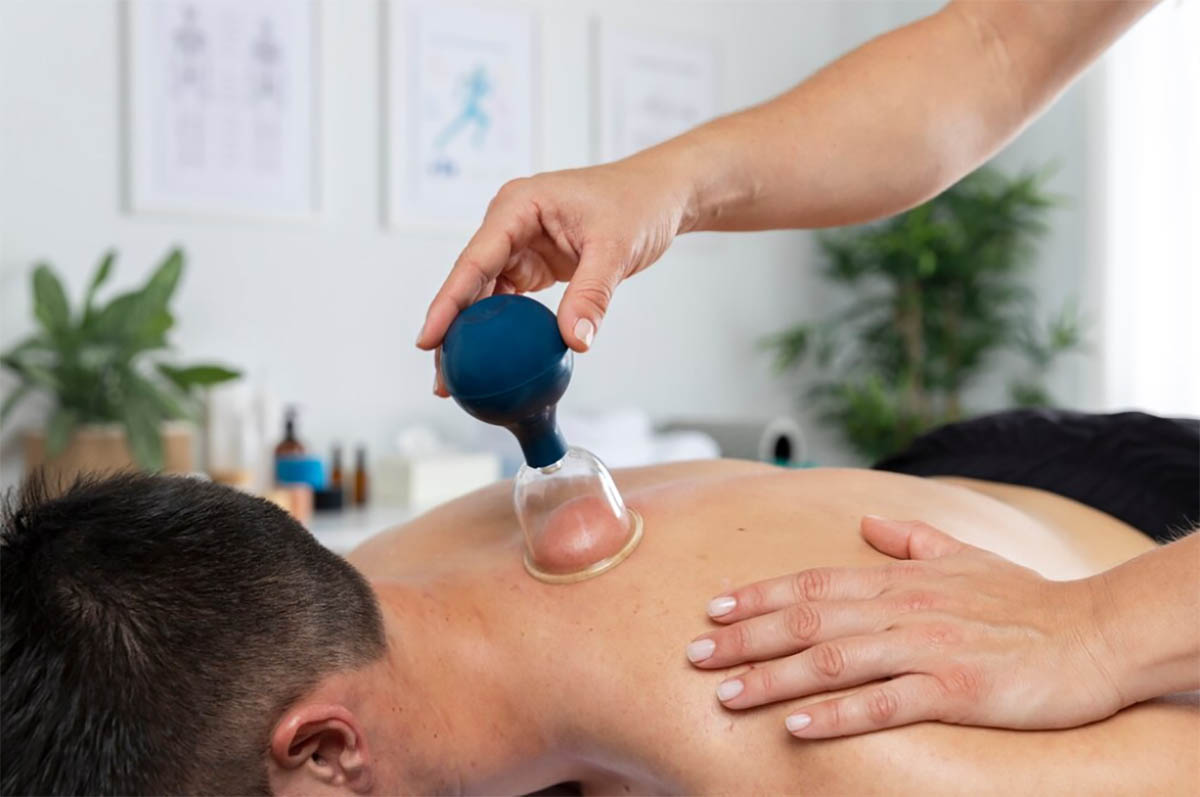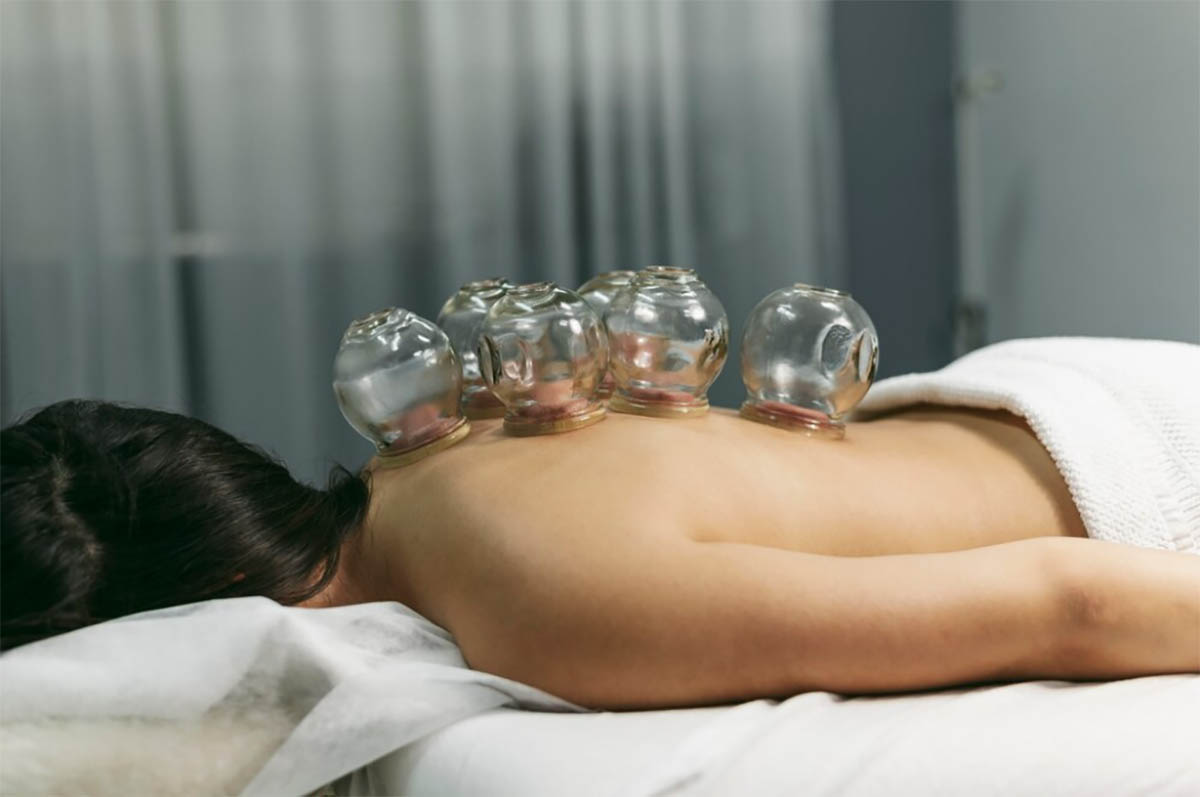Introduction
Back pain, particularly non-specific chronic low back pain, represents a condition affecting millions globally, leading to functional disability and a reduced quality of life. In the search for alternative and holistic treatments beyond conventional therapy, cupping for back pain, an ancient form of alternative medicine, has resurfaced in modern therapeutic practices.
This blog aims to dissect the effectiveness of cupping therapy, rooted in traditional Chinese medicine, for alleviating back pain, focusing on the application of cupping therapy, its methodological quality, and clinical outcomes based on current evidence, while exploring a wide range of treatment effects, including pain relief and disability improvement.
What is Cupping?
Cupping is a traditional Chinese medicine technique that employs suction cups to create negative pressure on the skin, aiming to enhance circulation and relieve muscle tension. The primary action of cupping involves the application of glass, bamboo, or silicone cups to the skin, which is then either heated or attached to a suction device to draw the skin and superficial muscle layer into the cup.
This ancient practice, deeply rooted in Chinese medicine and alternative medicine, is believed to stimulate blood vessels, improve blood circulation, and facilitate the healing process of various conditions, including chronic pain, body aches, and rheumatic diseases.
How Cupping is Supposed to Help with Back Pain
The unique action of cupping creates negative pressure, which is thought to increase blood flow to the affected area, promoting tissue repair and addressing issues like chronic non-specific neck pain and low back pain. By improving circulation and reducing tension, cupping is believed to enhance the range of motion, reduce functional disability, and contribute significantly to pain reduction outcomes. Additionally, by targeting connective tissue, cupping can help alleviate stiffness and promote physical function, offering a non-invasive solution to chronic pain management and leading to disability improvement.
Types of Cupping Techniques for Back Pain

Wet Cupping
Wet-cupping therapy combines suction with controlled medicinal bleeding, aiming to expel toxic blood from the body. This method aligns with traditional practices and is often used in the treatment of rheumatic diseases and to improve clinical outcomes related to inflammation and pain. The effectiveness of wet cupping has been observed in various studies, highlighting its role in pain relief and duration of symptom reduction.
Dry Cupping
Dry cupping therapy intervention, the more common form of cupping, involves only the application of suction cups without blood removal. This technique is particularly effective in managing chronic pain, improving functional disability, and enhancing the quality of life by stimulating blood flow, relieving muscle tension, and promoting healing.
Fire Cupping
Fire cupping uses glass cups and a quick flame to create suction, which is believed to penetrate deeper into the tissues. This traditional suction method can be particularly beneficial for deep tissue massage, addressing the emotional aspects and physical symptoms of chronic conditions.
Massage Cupping
Massage cupping is a variation that combines the suction effect of cupping with the healing power of massage. This technique aims to provide a comprehensive treatment that not only targets muscle stiffness and body aches but also promotes overall relaxation and pain relief.
Benefits of Cupping for Back Pain
Cupping therapy provides various potential benefits, especially for individuals suffering from chronic pain, such as:
- Increases Blood Circulation: The negative pressure from the suction cups is believed to open blood vessels, enhancing circulation and promoting tissue repair.
- Reduces Inflammation: Improved circulation can lead to reduced inflammation, which is often a significant factor in functional disability associated with back pain, thereby aiding in pain relief and recovery.
- Promotes Tissue Relaxation: By targeting the connective tissue, cupping helps to reduce stiffness, promoting relaxation and an improved range of motion, leading to disability improvement.
- Stimulates Healing: The action of cupping supports the body’s natural healing processes, addressing both physical function and psychological symptoms associated with chronic pain.
- Releases Trigger Points: Cupping therapy can aid in breaking down deep tissue knots, providing relief from chronic conditions, and improving the quality of life.
- Detoxification: The traditional belief behind wet-cupping therapy is that it helps remove toxins from the body, contributing to overall health.
- Promotes Relaxation: The process also addresses emotional aspects, offering a holistic treatment to chronic pain by reducing stress and promoting relaxation. While the process you have time to experience the thrill of online gaming at rubyslots casino. With a vibrant and playful ambiance adorned with colorful visuals and engaging characters, try out a diverse selection of over eighty slot machines and fifty other classic casino games, including roulette, blackjack, and poker, there’s something for every player’s taste.
Comparing Cupping with Other Back Pain Treatments
Is cupping good for back pain, and does cupping work for back pain ? These are common questions among those exploring cupping therapy for back pain relief. This therapy stands out due to its unique mechanism of creating negative pressure, contrasting with conventional therapies like medication or surgery, and even differing from other alternative treatments such as acupuncture or physical therapies.
Below is a comparison chart to help illustrate the differences between cupping and other common back pain treatment modalities:
| Treatment Method | Mechanism of Action | Benefits | Considerations |
| Cupping | Increases blood circulation, reduces inflammation | Non-invasive, holistic approach, detoxifies | Temporary marks, limited scientific research |
| Physical Therapy | Improves mobility and strength | Personalized care, long-term benefits | Requires time and commitment |
| Medication | Reduces pain and inflammation | Quick relief, accessible | Possible side effects, temporary solution |
| Acupuncture | Stimulates body’s pain points | Minimal side effects, promotes relaxation | Requires multiple sessions, practitioner dependency |
| Massage | Relieves muscle tension, improves circulation | Relaxation, immediate relief | Short-term effects, variability in technique |
This table is a general guide; individual experiences and results may vary. It’s important to consult with healthcare professionals to determine the best treatment plan for your specific needs.
Despite the positive anecdotal evidence supporting the notion that cupping is beneficial for back pain, the clinical evidence, especially for conditions like chronic non-specific low back pain, requires more robust research designs, larger sample sizes, and thorough statistical analysis to solidify its standing in clinical practice.
What should I expect after cupping?
Post-cupping, patients may experience marks from the suction cups, indicative of blood vessels’ reaction to the negative pressure. While these marks typically fade within a few days, they symbolize the detoxification and healing processes. It’s essential to monitor the body’s response and adhere to the treatment protocol suggested by the healthcare provider, including treatment time, duration of treatment, and evaluation times, to maximize benefits and reduce adverse effects.
Conclusion
Cupping therapy offers a unique approach to managing back pain, rooted in the traditions of Chinese medicine but increasingly scrutinized under the lens of modern science. While the quality of evidence and methodological quality of eligible studies vary, the anecdotal success and theoretical benefits related to improved blood circulation, detoxification, tissue relaxation, and pain relief warrant further exploration. As with any treatment, individuals should consult healthcare professionals, ensuring that cupping aligns with their health status, inclusion criteria, and treatment goals.
At Auto-Ness Physical Therapy, we offer unparalleled physical therapy in Scripps Ranch, San Diego, specializing in personalized treatments that go beyond conventional approaches. Our mission is to empower you to achieve lasting relief and improvement. Discover how to eliminate low back pain with our innovative strategies and expert care. Experience the difference with Auto-Ness Physical Therapy, where your recovery is our top priority.
FAQs
How effective is cupping for back pain?
Effectiveness varies, with some reporting significant relief from chronic conditions, while others notice subtle changes. The quality of evidence remains a critical area for future research, emphasizing the need for well-designed studies and robust clinical outcomes.
How often should I do cupping for back pain?
Frequency depends on individual needs and the treatment protocol. Generally, treatment sessions might start weekly, adjusting based on response and practitioner advice.
How long do you leave cupping on the back?
Typically, cups are left for 5 to 15 minutes, based on the intervention protocol and the individual’s tolerance. It’s crucial to follow professional guidelines to prevent adverse effects.



